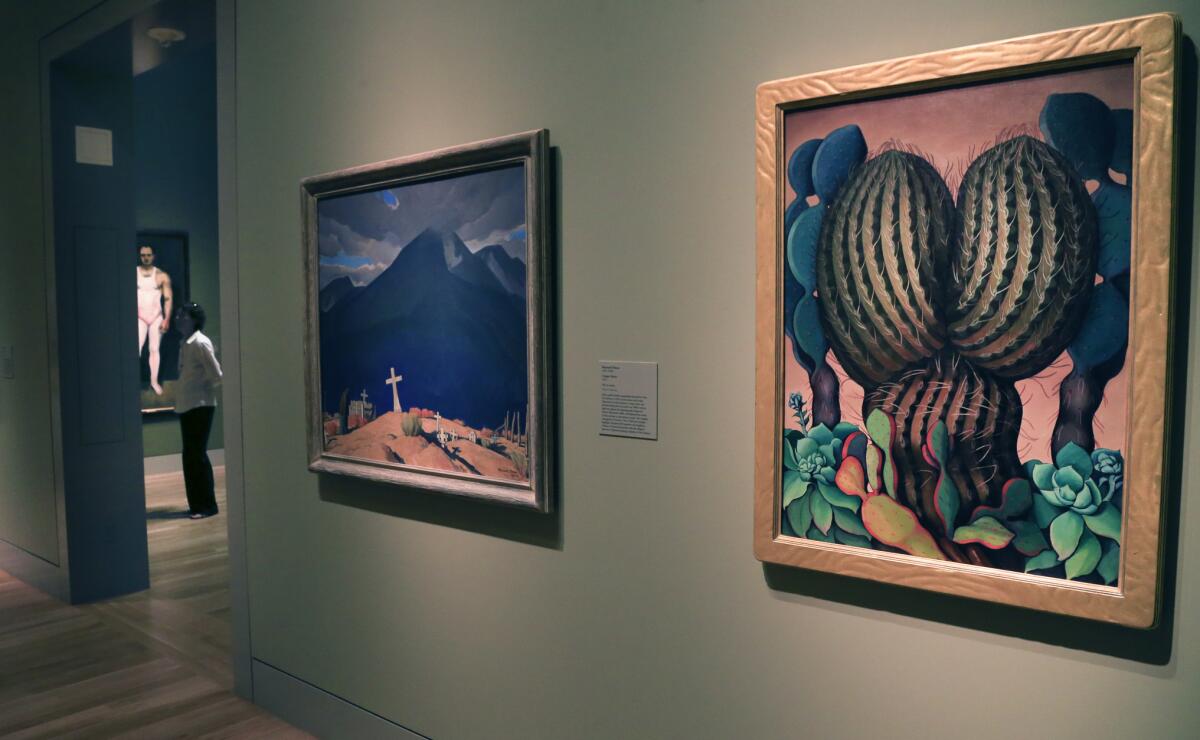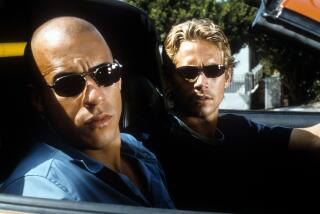Review: Huntington’s new gallery rooms show promise

- Share via
Sometimes an art museum opens new galleries more as an expression of ambition and possibility for the future than as the culmination of a completed achievement. That seems to be the case at the Huntington in San Marino, which on July 19 will inaugurate five new rooms in the Virginia Steele Scott Galleries of American Art.
The handsome new galleries, former storage rooms, show where the museum hopes to go. Specifically, the Huntington now has clear ambitions to develop a substantial collection of 20th century American art — one that will extend its already significant holdings in 18th and 19th century American paintings, sculptures, works on paper and decorative arts.
The 20th century — especially the 20th century vanguard — has never been of much interest in leafy San Marino. So it was a surprise in April when the Huntington announced it had acquired “Lattice and Awning,” a large, late, superlative canvas by Arthur Dove (1880-1946) — America’s first great abstract painter. Remarkably, it’s now the only Dove painting in a Los Angeles-area museum.
Making its debut, the 1941 picture holds court in a room devoted to interactions between landscape painting and early Modernism. The undulating, interlocking, sometimes spiky and always flat shapes in “Lattice and Awning” incorporate bare hints of the built environment in the vicinity of the artist’s Long Island studio. (Coincidentally, he lived in a neighborhood of the town of Huntington.) But the picture offers no sense of a landscape being abstracted.
In his work, Dove set aside the problem of painting as an illusion. Instead, with its autumnal palette of mossy greens, rusty browns, cream and gray, “Lattice and Awning” evokes nature being constructed — metaphorically hammered together, assembled with the tools of painting. (Dove’s father was a brick manufacturer and building contractor.) As the title implies, the painting proposes that great art is a structural framework and soulful shelter. It’s a great addition to the Huntington’s collection.
Two other outstanding Modernist pictures nearby are by Charles Reiffel, a recently rediscovered painter who moved from Connecticut to San Diego after World War I, and L.A. painter Henrietta Shore, whose stripped-down natural forms were influential to the artistic development of her friend, photographer Edward Weston. Reiffel’s vertiginous, 1916 Expressionist landscape performs a tense balancing act between apocalyptic upheaval and everlasting order. Shore’s pneumatic, voluptuous “Cactus” (undated but painted before 1927) is an eye-grabbing portrait of prickly eroticism.
Both paintings are on loan to the museum from private collectors.
In fact, of 14 paintings in the room, only six are in the Huntington’s collection. Public and private lenders have been generous, here and elsewhere in the inaugural presentation, where exemplary borrowed works by John McLaughlin, Louise Nevelson, Ed Ruscha, Frank Stella and other artists are installed. In the context of the gallery in which the great Dove hangs, it’s easy to see how far the museum has to go to develop its permanent holdings.
Also making its debut, although in the 19th century galleries, is a hazy, romantic vision of human promise by Robert Seldon Duncanson. Probably painted during a trip to Europe, “Landscape with Ruin” (circa 1853) compiles a litany of standard motifs to create an imaginary, moralizing vista. The scene is dominated by a robust tree magnificently silhouetted against the sky. Tiny travelers dwarfed by the immensity of the world take a journey through nature’s dramatic wilds, where a dilapidated castle on a hilltop is an enchanting symbol of both human aspiration and frailty.
Duncanson’s composition rhymes the stark foreground hills with pale but radiant mountains disappearing off into the remote distance. A luminous passageway is carved between them, toward which the little travelers proceed. One space spills into the next, like sand slipping through the narrows of an hourglass. The crumbling hilltop ruin looms above the opening — an emblem of mortality that may well make this enigmatic scene a spiritual narrative of the Christian promise of life after death.
Duncanson was largely self-taught and worked mostly in the Midwest, where he benefited from the patronage of several Ohio abolitionists. As an African American in a nation wracked by the evils of slavery, his prospects were limited.
The Duncanson is one of three significant works by African Americans acquired recently by the Huntington. As it grows its collection, the museum is making a concerted effort to recognize diversity. A prodigious Art Deco organ screen carved in 1937 by Bay Area sculptor Sargent Claude Johnson is dominated by a stylized tree of life — a motif that echoes the vital tree standing tall in Duncanson’s landscape. Hanging next to the carved relief is “Soldier,” a dryly linear figure painted in tempera during World War II by Charles White, who became influential after moving to L.A. in 1956.
White’s monumental, bayonet-wielding infantryman stands alone on a desolate plain looking skyward. African sculpture, Cubism and Social Realism stylistically merge. Emotionally the soldier is an equally complex union of brute power and tender vulnerability.
The American collection still needs powerful examples of Spanish Colonial painting or sculpture. The story of American art was once told only in nationalist terms, starting in the East and moving West, as if an aesthetic version of Manifest Destiny. But history isn’t that linear or neat: When Duncanson was on his first sketching tour of the Hudson River Valley, the American Southwest was part of Mexico.
Ironically, the museum’s new galleries had their partial unveiling last year as the site for the illuminating temporary exhibition “Junipero Serra and the Legacies of the California Missions,” which featured numerous fine works by such important 18th century Mexican artists as José de Páez. The Huntington is mixing up the established story of American art in various beneficial ways — for instance, integrating early 20th century plein-air painting in Southern California with roughly contemporaneous Modernist works by Shore, Georgia O’Keeffe and Maynard Dixon. A few well-chosen Spanish Colonial examples in the permanent collection galleries would be revealing.
Artistically, the museum is of course internationally identified with its incomparable collections of 18th century British Grand Manner portraiture, housed in the Huntington mansion. Railroad baron and art collector Henry E. Huntington (1850-1927) was a committed Anglophile, but nearly a century ago he began to add a few Colonial American paintings to his collection. They included John Singleton Copley’s portrait of a man who may or may not be President Martin van Buren as well as an unidentified artist’s 18th century copy of a Charles Willson Peale portrait of a man who is most definitely George Washington.
Notably, the American paintings that most interested Huntington were made by artists who went to London to study or work. Another, better Copley portrait of two aristocratic young brothers (and their playful dog) shows landed gentry coming to maturity in Essex, England — teenage lads on a country estate not unlike the one Huntington was elaborating for himself in San Marino. The double portrait was painted after Copley left Boston for Europe in 1776 to make his way as an artist — and who could really blame him for going? Revolution at home was a world-changing adventure, but Boston, a small town of perhaps 15,000 souls, could hardly compete as a source of patronage with a world capital like London.
The Huntington’s American art collection remained small until 1984, when new galleries opened to house a bequest of 50 paintings from a foundation established by the late Virginia Steele Scott.
According to an essay by Huntington curator Jessica Todd Smith in a useful new catalog of the museum’s American collection, during a foreign sojourn in 1938 Virginia married the dashing Jonathan Hartley Folliott Scott — coincidentally, a British painter. (She was 33, he was 24; eventually the couple separated but never divorced.) They collected art, but most of what later went to the museum was bought by the Scott Foundation after her death. Today the collection numbers some 12,000 works, 90% of them drawings, photographs and prints.
Practically speaking, the Huntington is not an encyclopedic museum, so there’s no reason to expect its American art collection to be comprehensive. Instead, the quality of individual acquisitions is what counts.
The terrific new Dove and Duncanson plainly demonstrate that. So do wonderful loans like the Reiffel, Shore and several others. They show that a lot is still possible. Turning storage rooms into new galleries is a pretty frank declaration that the museum has a plan.
christopher.knight@latimes.com
More to Read
The biggest entertainment stories
Get our big stories about Hollywood, film, television, music, arts, culture and more right in your inbox as soon as they publish.
You may occasionally receive promotional content from the Los Angeles Times.











